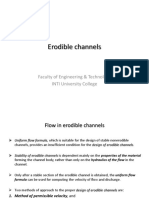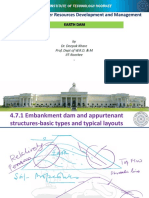Collapsible Soils
Collapsible Soils
Uploaded by
Jose2806Copyright:
Available Formats
Collapsible Soils
Collapsible Soils
Uploaded by
Jose2806Original Description:
Copyright
Available Formats
Share this document
Did you find this document useful?
Is this content inappropriate?
Copyright:
Available Formats
Collapsible Soils
Collapsible Soils
Uploaded by
Jose2806Copyright:
Available Formats
COLLAPSIBLE SOILS
Collapsible soils These are unsaturated soils that can withstand relatively large imposed stresses with small settlement at low in situ moisture content but will exhibit a decrease in volume and associated settlement (which could be of large magnitude) with
no increase in applied stress if wetting occurs
Water bridge Water bridge
Soil grains
Water bridge
Occurrence in the world Extensive deposits occur world wide e.g. sensitive clays of Scandinavia and eastern Canada loess formations of China, Russia and eastern Berea Red Sands of the southern African east coast. Residual soils such as the Highveld granites of South Africa Kalahari sands The black cotton soils of Northeastern Nigeria, Cameroon and Chad
etc
Origin Granite Weathered Residual granite
quartz, mica flakes, kaolinite
It is characterized by quartz grains embedded in some silt materials together with fine sand and colloidal matter
Rainfall will leach out the soluble colloidal material leaving a honey comb structure In dry environment coupled with the little salts in place the joints where the quartz grains meet some moisture will be trapped so the honey comb structure can withstand some considerable force when dry but when saturated collapses and creates a host of collapsible soil problems
Characteristics
Have an open structure
Have a high void ratio Have a low dry density Have a high porosity Are geologically young or recently altered deposit Have a high sensitivity Have a low inter particle bond strength
The behavior of collapse is illustrated below
Time s e t t l e m e n t Normal settlement with soil partially saturated
Additional settlement with no change in applied pressure but increase in moisture content
According to Dudley (1970), and Harden et al., (1973), four factors are needed to produce collapse in a soil structure: 1. An open, partially unstable, unsaturated fabric 2. A high enough net total stress that will cause the structure to be metastable 3. A bonding or cementing agent that stabilizes the soil in the unsaturated condition 4. The addition of water to the soil which causes the bonding or cementing agent to be reduced, and the inter-aggregate or inter-granular contacts to fail in shear, resulting in a reduction in total volume of the soil mass. Collapsible behavior of compacted and cohesive soils depends on the percentage of fines, the initial water content, the initial dry density and the energy and the process used in compaction.
Why do we have problems with collapsible soils?
Either one or all of the following problems may allow collapse to be evident in construction 1. Construction was carried out before collapse phenomenon was identified
2. No geotechnical assessment was carried out
3. In case the geotechnical assessment was done, it did not evaluate correctly or idenity potential collapsible soils within the profile 4. Recommendations given by the Geotechnical engineer was ignored by the parties invoved in the design
Evaluation and prediction
Field Identification
Observational method Look for cracking and building distortion Soil profiling Recognize a loose or open fabric Use a hand lens to look for colloidal coatings and clay bridges Sausage test- Carve out two cylindrical sample of undisturbed material to nearly as
possible to same diameter and height. Wet and knead one sample and remould it to the
same dimensions you had. A decrease in height when compared with the undisturbed material is indicative of collapsible material
Laboratory testing
Particle size distribution Atterberg limits Dry density
Consolidometer tests 1. Double oedometer Tests i. ii. Plot the e-log p graphs for both specimens. Evaluate the in situ effective pressure, Po. Draw a vertical line corresponding to the pressure Po. iii. From the e-log p curve of the soaked specimen, determine the pre consolidation pressure, Pc.
iv.
v.
Determine eo, corresponding to Po from the e-log p curve of the soaked specimen.
Through point (Po, eo) draw a curve that is comparable to the e-log p curve obtained from the specimen tested at natural moisture content.
vi.
Determine the incremental pressure, p, on the soil caused by the construction of
the foundation. Draw a vertical line corresponding to the pressure of Po + p in the e-log p curve. vii. Now, determine es and ec. viii. The settlement of soil without change in the natural moisture content is S1 = es/ (1 + eo) x H Also, the settlement caused by the collapse of the soil structure is S1 = ec/ (1 + eo) x H where H = the thickness of soil vulnerable to collapse
The single consolidometer test.
This is a simpler test to perform since
the interpretations of double oedometer test is cumbersome Only one undisturbed sample is tested The sample in the consolidometer is loaded to the expected stress from the structure and then soaked Consolidation from natural moisture content and the additional obtained from soaking is calculated This method is advantageous in that you can monitor the loading and moisture content paths
to which the soil will be subjected in the field.
Disadvantage this method over predicts settlement
The Collapse Potential Test
The collapse potential test is a special case of the single consolidometer test Sample is saturated at a load of 200 kPa (Schwartz, 1985). According to Jennings and Knight (1975) the Collapse Potential is not a design parameter, but is an index figure providing the engineer with a guide to the collapse situation and whether there is good reason for further investigation. The table below gives guidance as to the severity of collapse
Triaxial testings Stress path testing can be done which will be carried out only by training institutions and not commercial labs
Sampling Procedures
Use representative undisturbed samples for testings
Use block samples cut by hand from a test pit or trial trench Take samples in the field directly into consolidometer rings.
Insitu Tests Any in situ test must be designed to compare the stress deformation curves of the soil at its natural moisture content with that of the saturated condition. Plate loading tests have been used in many instances
Engineering Solutions
1. Precluding the triggering mechanism
Ensure that the water does not reach the collapsing soil horizons. 2. Chemical stabilization Stabilizing agent may increase the strength of colloidal bridges. Research on this area is limited. Use of sodium silicate and injection of carbon dioxide have been suggested (Semkin et al., 1986).
3. Piled and pier foundations Structural loads may be transferred through the collapsible soils by means of piled or pier foundations. This method is suitable for soils whose origin is transported. Then in that case the transported soil which is collapsible is shallow and underlain by stable soils or rock. 4. Design for the collapse as quantified increasing structural flexibility by the provision of joints or reducing the bearing pressures to restrict collapse settlement. Raft foundations are suitable for this Make sure there is no increase in moisture in the underlying soil with time.
5. Densification
For footings of foundations densification should be limited to 1.5 times the minimum plan dimension of footings and the soil should be compacted to sufficient density such that the CP < 1% down to the accepted depth of influence
For road works compact to 90% Mod ASSHTO for 0-0.5 m and 85% ASSHTO for 0.5-1m This could be combined with removal and compaction Vibroflotation Dynamic compaction In situ densification by surface rolling- Use impact and vibratory rollers References Expansive soils : problem soils in South Africa - state of the art by K Schwartz The occurrence and extent of collapse settlement in residual granite in the Stellenbosch area by NANINE GILDENHUYS
Geotechnical engineering - Principles and Practices of Soils Mechanics and Foundation Engineering
You might also like
- Geotechni Engineering Principle and Prac PDFDocument10 pagesGeotechni Engineering Principle and Prac PDFCarlos Bahamonde OjedaNo ratings yet
- Soil Mechanics Chapter Diploma in Civil Engineering 1Document14 pagesSoil Mechanics Chapter Diploma in Civil Engineering 1Gagan100% (1)
- Pharmaceutical Dosage Forms Answer Key-GREEN PACOPDocument25 pagesPharmaceutical Dosage Forms Answer Key-GREEN PACOPKitkat Casacop100% (3)
- Material Safety Data Sheet: Product: G Paint Lacquer PaintsDocument4 pagesMaterial Safety Data Sheet: Product: G Paint Lacquer PaintsYap HSNo ratings yet
- SoilMech Ch1 Classification PDFDocument12 pagesSoilMech Ch1 Classification PDFmichalakis483No ratings yet
- Erodible ChannelsDocument32 pagesErodible ChannelsfarooqNo ratings yet
- Guideline For Problem Soils in Sa June 2007Document75 pagesGuideline For Problem Soils in Sa June 2007Dian PageNo ratings yet
- Foundation Engineering I CE-325: Chapter 3: Bearing Capacity of Shallow FoundationsDocument17 pagesFoundation Engineering I CE-325: Chapter 3: Bearing Capacity of Shallow FoundationsRobert Prince100% (1)
- Earth Dam-Khare-Sep-2021-001Document140 pagesEarth Dam-Khare-Sep-2021-001ama kumarNo ratings yet
- Lecture 2 - Bearing Capacity of Shallow FoundationsDocument64 pagesLecture 2 - Bearing Capacity of Shallow FoundationsanilNo ratings yet
- Soil Comp Action Test Report by Yasas89Document6 pagesSoil Comp Action Test Report by Yasas89yasas8991% (11)
- Soil MechanicsDocument18 pagesSoil MechanicsGV Rama Subba RaoNo ratings yet
- Falling Head Permeability Lab TestDocument6 pagesFalling Head Permeability Lab TestHamierul MohamadNo ratings yet
- Soil Mechanics: Fourth EditionDocument86 pagesSoil Mechanics: Fourth EditionTatenda PaduzeNo ratings yet
- Oedometer TestDocument5 pagesOedometer TestAshokan Keloth100% (1)
- Ce 382 Classification of Soil 1442Document68 pagesCe 382 Classification of Soil 1442Carla Marie CefreNo ratings yet
- LateralEarthPressures DR S. G. Shah - F PDFDocument118 pagesLateralEarthPressures DR S. G. Shah - F PDFSG ShahNo ratings yet
- Ground ImprovementDocument17 pagesGround Improvementpatelahmad77100% (1)
- Design Aspects of An Earth Dam-Lab SheetDocument6 pagesDesign Aspects of An Earth Dam-Lab SheetAngel HasnaNo ratings yet
- Bearing Capacity11mAR15Document129 pagesBearing Capacity11mAR15Nandon Roy100% (1)
- Experiment 7: Field Density (Sand Cone Method)Document8 pagesExperiment 7: Field Density (Sand Cone Method)Thanaa' Marabeh100% (1)
- Calculation of Foundation Settlement and Coefficient of Soil Subgrade ReactionDocument10 pagesCalculation of Foundation Settlement and Coefficient of Soil Subgrade ReactionleodegarioporralNo ratings yet
- Foundations On Collapsible and Expansive Soils An OverviewDocument7 pagesFoundations On Collapsible and Expansive Soils An Overviewbinu johnNo ratings yet
- Lecture 4 Effective StressDocument18 pagesLecture 4 Effective StressAdi Fikri Sidi86% (7)
- Highway ReportDocument257 pagesHighway ReportMarlon Rampersad100% (1)
- Culvert DesignDocument27 pagesCulvert DesignNkosi DubeNo ratings yet
- Bridge Design 4 - Design of SuperstructuresDocument12 pagesBridge Design 4 - Design of SuperstructuresgabemzamanNo ratings yet
- CBR Method of Design of Flexible PavementDocument5 pagesCBR Method of Design of Flexible PavementHari R100% (1)
- Design Details Concrete Chute Spillways PDFDocument6 pagesDesign Details Concrete Chute Spillways PDFMarcelo Protz100% (1)
- Chapter 1 Basics of Dam EngineeringDocument17 pagesChapter 1 Basics of Dam Engineeringeph100% (1)
- Soil Lab ManualDocument39 pagesSoil Lab ManualHuy PanhaNo ratings yet
- Gofar & Kassim, Introduction To Geotechnical Engineering Part 1Document190 pagesGofar & Kassim, Introduction To Geotechnical Engineering Part 1leen100% (3)
- Compressibility of SoilDocument7 pagesCompressibility of SoiljuryNo ratings yet
- CBR MDD Index Correlation Study-Addis Ababa University - 2013Document172 pagesCBR MDD Index Correlation Study-Addis Ababa University - 2013nimm1962No ratings yet
- What Is Foundation Settlement? Its Types and CausesDocument5 pagesWhat Is Foundation Settlement? Its Types and CauseslaikienfuiNo ratings yet
- Pressure Meter TestDocument18 pagesPressure Meter TestSiddhanth S Nair100% (1)
- Modulus of Subgrade ReactionDocument41 pagesModulus of Subgrade Reactionsuryakanta padhi100% (1)
- Chapter 3 Lateral Earth PressureDocument47 pagesChapter 3 Lateral Earth PressureJiregna Tesfaye100% (2)
- Permeability in SoilsDocument47 pagesPermeability in SoilsRusmar LaverosNo ratings yet
- Effect of Water Table On Allowable Bearing CapacityDocument4 pagesEffect of Water Table On Allowable Bearing Capacitykalpanaadhi100% (1)
- CE 323-Highway Engineering I Editted 2011Document118 pagesCE 323-Highway Engineering I Editted 2011Athiyo Martin100% (1)
- Unconfined Compression TestDocument6 pagesUnconfined Compression TestBahaaAbdalkareemNo ratings yet
- Design of Bridge StructuresDocument220 pagesDesign of Bridge StructuresVimalSharma100% (7)
- Consolidation TestDocument25 pagesConsolidation TestBefkadu KurtaileNo ratings yet
- Slope Stabillity Analysis & Its StabillisationDocument20 pagesSlope Stabillity Analysis & Its StabillisationakurilNo ratings yet
- 5 One Dimensional Flow of Water Through SoilsDocument28 pages5 One Dimensional Flow of Water Through SoilsJenina LogmaoNo ratings yet
- Lecture 10 Pavement DesignDocument17 pagesLecture 10 Pavement Designceanil100% (2)
- Soil Shear StrengthDocument89 pagesSoil Shear Strengthmuhd nizamNo ratings yet
- Introduction To Retaining WallDocument51 pagesIntroduction To Retaining Wallkalaivannan77No ratings yet
- Utilization of Recycled Concrete Aggregates For Light-Stabilization of Clay SoilsDocument11 pagesUtilization of Recycled Concrete Aggregates For Light-Stabilization of Clay SoilsApoorva AgarwalNo ratings yet
- Soil Young's ModulusDocument1 pageSoil Young's ModulusAndre UlianovNo ratings yet
- A Sample of Wet Soil Has A Volume of 0Document8 pagesA Sample of Wet Soil Has A Volume of 0eph0% (1)
- Dispersive SoilsDocument11 pagesDispersive Soilskundayi shava50% (2)
- Compaction TestDocument12 pagesCompaction Testaidil adhaNo ratings yet
- Culvert အကြောင်းသိကောင်းစရာများ (Saya Thet Lwin)Document91 pagesCulvert အကြောင်းသိကောင်းစရာများ (Saya Thet Lwin)Myanmar ZorroNo ratings yet
- Dams - C5 - Foundation and Abutment PreparationDocument4 pagesDams - C5 - Foundation and Abutment PreparationJohan Vd Merwe Snr100% (1)
- Assignment 4Document2 pagesAssignment 4sstibisNo ratings yet
- Group 1 Geotech FinalDocument13 pagesGroup 1 Geotech FinalTakudzwa Calvin ChibudaNo ratings yet
- University of Zimbabwe Faculty of EngineeringDocument9 pagesUniversity of Zimbabwe Faculty of EngineeringTakudzwa Calvin ChibudaNo ratings yet
- Expansive Soil-CoTMDocument63 pagesExpansive Soil-CoTMZeleke Taimu100% (2)
- January 20, 2021 CE 401 - CE31S6 Geotechnical Engineering 1 (Soil Mechanics) GROUP - (5 Members)Document5 pagesJanuary 20, 2021 CE 401 - CE31S6 Geotechnical Engineering 1 (Soil Mechanics) GROUP - (5 Members)Katy PerryNo ratings yet
- ASTM D7039-15a (Reapproved 2020)Document12 pagesASTM D7039-15a (Reapproved 2020)Jose2806No ratings yet
- NORSOK M-710-2014-AC-2019 - enDocument8 pagesNORSOK M-710-2014-AC-2019 - enJose2806100% (1)
- Garsin Engineering Steel Tubing Product ListDocument21 pagesGarsin Engineering Steel Tubing Product ListJose2806No ratings yet
- Yuken 8 EDFHG-AMN English LeafletDocument4 pagesYuken 8 EDFHG-AMN English LeafletJose2806No ratings yet
- Matrix Method For Analysis of Hydraulic NetworksDocument9 pagesMatrix Method For Analysis of Hydraulic NetworksJose2806No ratings yet
- Boundary Element MethodDocument12 pagesBoundary Element MethodRam KumarNo ratings yet
- Portal Connection Details 181Document8 pagesPortal Connection Details 181Hoa Da100% (1)
- Higher Order 2D Solid Elements. Shape Functions andDocument29 pagesHigher Order 2D Solid Elements. Shape Functions andJose2806No ratings yet
- 45 Vibrating ScreensDocument12 pages45 Vibrating ScreensJose2806100% (2)
- CH 4 Incremental Elastoplastic Analysis-Hinge by Hinge MethodDocument31 pagesCH 4 Incremental Elastoplastic Analysis-Hinge by Hinge MethodJose2806No ratings yet
- Sonochemical Degradation of Cyclic Nitroxides in Aqueous SolutionDocument6 pagesSonochemical Degradation of Cyclic Nitroxides in Aqueous SolutionJohn F. GuatequeNo ratings yet
- The Nature of EnergyDocument35 pagesThe Nature of EnergyJustine Valad-onNo ratings yet
- Figure 1.1 Distributed-Mass Models Figure 1.2 Lumped-Mass ModelsDocument13 pagesFigure 1.1 Distributed-Mass Models Figure 1.2 Lumped-Mass Modelspattrapong pongpattraNo ratings yet
- Design For ShaftDocument60 pagesDesign For ShaftMarlNo ratings yet
- Byjus'sDocument53 pagesByjus'sSobhit Ranjan Panda100% (1)
- R600a Iso Butane PT Chart PDFDocument2 pagesR600a Iso Butane PT Chart PDFKesavReddyNo ratings yet
- Chemical Engineering Design & Safety: CHE 4253 Prof. Miguel BagajewiczDocument11 pagesChemical Engineering Design & Safety: CHE 4253 Prof. Miguel BagajewiczJOBRAN SofienNo ratings yet
- Chemistry Presentation of Class 11 About Purification of WaterDocument14 pagesChemistry Presentation of Class 11 About Purification of WaterGautam Dhital100% (1)
- Privious Year Question 2019Document12 pagesPrivious Year Question 2019Haripratap SikarwarNo ratings yet
- F Ma M (DV/DT) D (MV) /DT FDT D (MV)Document7 pagesF Ma M (DV/DT) D (MV) /DT FDT D (MV)igammoh123No ratings yet
- Midterm Examination Organic ChemistryDocument4 pagesMidterm Examination Organic ChemistryMichael Padilla Esmalla100% (1)
- Final Sem PHY102Document7 pagesFinal Sem PHY102Sandipani Mishra 21238No ratings yet
- Anilari RasDocument7 pagesAnilari Rassiva RamNo ratings yet
- Thermal Analysis of Air Cooled Synchronous Generator: Jehan ShazlyDocument8 pagesThermal Analysis of Air Cooled Synchronous Generator: Jehan ShazlyAnonymous q8EusUCNo ratings yet
- Prac-4 StoichiometryDocument23 pagesPrac-4 StoichiometryCristiano PassarelliNo ratings yet
- Ebook (ISE) Introduction To Chemical Engineering Thermodynamics, 9e Hendrick Van Ness, Michael Abbott, Joseph Mauk Smith, Mark Thomas SwihartDocument35 pagesEbook (ISE) Introduction To Chemical Engineering Thermodynamics, 9e Hendrick Van Ness, Michael Abbott, Joseph Mauk Smith, Mark Thomas Swihartdding3592No ratings yet
- EEE - Engineering Chemistry Lab Manual New 2019-20Document54 pagesEEE - Engineering Chemistry Lab Manual New 2019-20angel zoeNo ratings yet
- Nano Energy: Fei Li, Li Zhang, Jincheng Tong, Yingliang Liu, Shengang Xu, Yan Cao, Shaokui CaoDocument10 pagesNano Energy: Fei Li, Li Zhang, Jincheng Tong, Yingliang Liu, Shengang Xu, Yan Cao, Shaokui CaoDina PradinaNo ratings yet
- Ncert SolutionsDocument41 pagesNcert SolutionsAni PatelNo ratings yet
- Sources of Oxygen Contamination in SAW - EagerDocument5 pagesSources of Oxygen Contamination in SAW - EagerAndres CasteloNo ratings yet
- Natsci1 Reference2 Lesson19 PDFDocument8 pagesNatsci1 Reference2 Lesson19 PDFPercen7No ratings yet
- Viii-1 QuestionsDocument4 pagesViii-1 QuestionsAhmad FaujiNo ratings yet
- Evaluation of Polymer Flooding For Enhanced Oil Recovery in The Norne Field E-Segment PDFDocument83 pagesEvaluation of Polymer Flooding For Enhanced Oil Recovery in The Norne Field E-Segment PDFstbernardjNo ratings yet
- Vmoc 206 XXDocument40 pagesVmoc 206 XXPatrice PaulNo ratings yet
- 11 ChapterDocument24 pages11 ChapterShashwat SahayNo ratings yet
- Liquid Pentrant TestingDocument55 pagesLiquid Pentrant TestingRamesh R100% (1)
- ZQYM Common Rail Test Bench Concise Function Sheet - Erica 2023.09Document4 pagesZQYM Common Rail Test Bench Concise Function Sheet - Erica 2023.09harbh9355No ratings yet
- Part 1 (FLP) CompleteDocument2 pagesPart 1 (FLP) CompleteZahid Nawaz KhanNo ratings yet



































































































